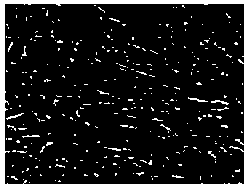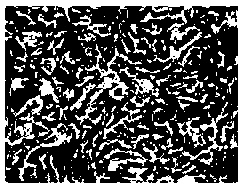Virus isolation method for low-content sore mouth virus sample
A canker sore virus and virus separation technology, which is applied in the field of virus isolation of samples with low content of canker sore virus, can solve the problems of time-consuming, inability to isolate cane canker sore virus, and restricting researchers' access to wild canker sore virus strains, etc., and achieves the separation cycle. Short, maintain integrity and activity, good integrity and activity
- Summary
- Abstract
- Description
- Claims
- Application Information
AI Technical Summary
Problems solved by technology
Method used
Image
Examples
Embodiment 1
[0050] Step 1: Handling of materials:
[0051] Processing method of saliva and milk samples:
[0052] After centrifugation at 12000r / min for 10min, take 200μL supernatant, add 800μL Virus holder solution, freeze and thaw 3 times, filter with 0.22μm filter membrane, and store the filtrate at -20℃ for later use;
[0053] Liver, kidney and other visceral sample processing methods:
[0054]Take 0.5g sample, wash it twice with sterile PBS, cut it into pieces, add 1mL Virus holder solution, grind until homogenized with a homogenizer, freeze and thaw repeatedly 3 times, centrifuge at 5000r / min for 5min, take the supernatant, filter at 0.22μm Membrane filtration, the filtrate was stored at -20°C for later use;
[0055] Step 2: Virus isolation:
[0056] Take 1mL of the filtrate and inoculate the bovine testicular primary cells that have covered 90% of the bottom of the culture flask, at 37°C, 5% CO 2 Discard the venom after incubating in the incubator for 1 hour;
[0057] Add 10mL...
Embodiment 2
[0067] Step 1: Handling of materials:
[0068] Processing method of saliva and milk samples:
[0069] After centrifugation at 14000r / min for 7min, take 200μL supernatant, add 800μL Virus holder solution, freeze and thaw 3 times, filter with 0.22μm filter membrane, and store the filtrate at -20℃ for later use;
[0070] Liver, kidney and other visceral sample processing methods:
[0071] Take 0.5g sample, wash it twice with sterile PBS, cut it into pieces, add 1mL Virus holder solution, grind until homogenized with a homogenizer, freeze and thaw three times, centrifuge at 4000r / min for 7min, take the supernatant, filter at 0.22μm Membrane filtration, the filtrate was stored at -20°C for later use;
[0072] Step 2: Virus isolation:
[0073] Take 1mL of the filtrate and inoculate 85% of the bovine testicular primary cells at the bottom of the culture flask, at 37°C, 5% CO 2 Discard the venom after incubating in the incubator for 1 hour;
[0074] Add 7mL cell maintenance solut...
Embodiment 3
[0084] Step 1: Handling of materials:
[0085] Processing method of saliva and milk samples:
[0086] After centrifugation at 16000r / min for 5min, take 200μL supernatant, add 800μL Virus holder solution, freeze and thaw 3 times, filter with 0.22μm filter membrane, and store the filtrate at -20℃ for later use;
[0087] Liver, kidney and other visceral sample processing methods:
[0088] Take 0.5g sample, wash it 3 times with sterile PBS, cut it into pieces, add 1mL Virus holder solution, grind it with a homogenizer until it is homogenized, freeze and thaw it repeatedly 3 times, centrifuge at 3000r / min for 10min, take the supernatant, filter it at 0.22μm Membrane filtration, the filtrate was stored at -20°C for later use;
[0089] Step 2: Virus isolation:
[0090] Take 1mL of the filtrate and inoculate the bovine testicular primary cells that have covered 80% of the bottom of the culture flask, at 37°C, 5% CO 2 Discard the venom after incubating in the incubator for 1.5 hour...
PUM
 Login to View More
Login to View More Abstract
Description
Claims
Application Information
 Login to View More
Login to View More - R&D
- Intellectual Property
- Life Sciences
- Materials
- Tech Scout
- Unparalleled Data Quality
- Higher Quality Content
- 60% Fewer Hallucinations
Browse by: Latest US Patents, China's latest patents, Technical Efficacy Thesaurus, Application Domain, Technology Topic, Popular Technical Reports.
© 2025 PatSnap. All rights reserved.Legal|Privacy policy|Modern Slavery Act Transparency Statement|Sitemap|About US| Contact US: help@patsnap.com



